Japanese Zelkova bonsai care
Japanese zelkova bonsai care at a glance
| Cold tolerance | Fairly strong |
| Heat tolerance | Fairly strong |
| Drought tolerance | Fairly strong |
| Sun exposure | Full sun |
| Soil mix | Akadama/volcanic rock: 50% Pumice: 30% Organic compost: 20% |
| Watering | 1-2 /day in spring and fall 2-3 times/day in summer Once every 2-3 days in winter |
What is Japanese zelkova (Japanese elm)?

Japanese zelkova bonsai
Japanese zelkova (Zelkova serrata) or Japanese elm is a medium-sized deciduous tree that belongs to the Ulmaceae family. It is native to East Asia, particularly Japan, China, and Korea.
Japanese Zelkova is celebrated for its graceful and elegant appearance in broom-like form, beautiful light green foliage and smooth bark. Its leaves are naturally small, growing only to 2 inches (5cm) long even with a mature, full-sized tree.
There are 6 species in the genus zelkova, of which Japanese zelkova and Chinese elm are commonly grown as bonsai trees.
Placing Japanese zelkova bonsai: indoor or outdoor?
Sunlight requirements

Japanese zelkova bonsai trees thrive when they receive direct sunlight all day during the growing season. Full sun exposure promotes vigorous growth, vibrant foliage, and overall health. They are generally not shade-tolerant trees and require substantial light for optimal growth.
That said, some protection from the intense midday sun may be necessary if you live in regions with scorching summers. This can be achieved by providing partial shade during the hottest part of the day.
Indoor or outdoor?
Japanese zelkova trees require a substantial amount of direct sunlight, 6 hours or more per day during the growing season. This makes Japanese zelkova bonsai ill-suited for indoor cultivation in the long term.
Indoors, it may be challenging to provide the intense and prolonged sunlight that Japanese zelkova bonsai need to thrive. Even placing them near windows may not offer sufficient light.
So, Japanese zelkova bonsai are primarily outdoor plants, and they should be grown in an outdoor environment that provides the necessary sunlight, temperature fluctuations, and seasonal changes to support their growth and overall health.
But if you do want them indoors, the only option for indoor placement is to place them AT and NOT NEAR the south or east-facing windows where your Japanese zelkova bonsai receives at least 6 hours of sunlight.
Watering
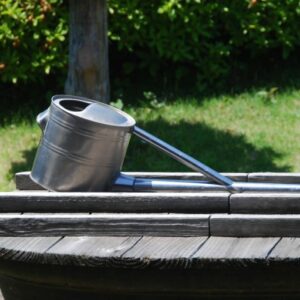
Proper watering is a fundamental aspect of Japanese zelkova bonsai care.
As a general guide, Japanese zelkova bonsai should be watered;
-
- Once to twice/day in spring and fall
- Twice or three times/day in summer
- Once every 2 to 3 days in winter
Japanese zelkova trees thrive with plenty of water, especially once their leaves start growing in spring. Keep an eye on the soil moisture to ensure it doesn’t dry out.
It is important to water them more often in summer or in windy days because Japanese zelkova trees have numerous leaves and release moisture constantly through them.
Also during the summer, it’s good practice to water the leaves in the evening. Water opens the leaf pores (stomata) that are closed by the strong daytime sunlight and cool down the tree, which is beneficial for growth.
If you want to know more about the benefits of watering leaves, please check the following post.
Repotting
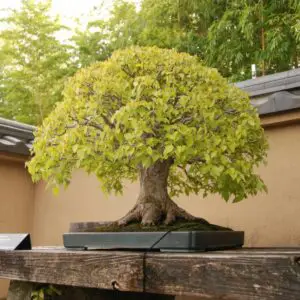
Japanese zelkova bonsai
Repotting is a crucial aspect of Japanese zelkova bonsai care that ensures the continued health and vitality of your tree.
How often to repot
Younger Japanese zelkova trees should be repotted every 1 to 2 years as they are prone to rootbound. Mature trees should be repotted every 2 years.
When to repot
The optimal period for repotting Japanese zelkova bonsai is before the new spring buds appear, which is around March depending on the climate.
Best soil mix for Japanese zelkova bonsai
The best soil mix for Japanese zelkova bonsai is;
- Akadama/volcanic rock: 50%
- Pumice: 30%
- Organic compost: 20%
The soil should have good water retention as well as drainage. The balance is important: if the soil drains water too quickly, the branches tend to grow thicker, and your bonsai loses its charm as Japanese zelkova bonsai.
Also, it’s recommended to use smaller grain soil compared to other bonsai varieties. This helps promote the growth of fine roots which leads to finely ramified branches.
If you prefer pre-mixed bonsai soil, there are products specifically formulated for bonsai trees as follows.
How to repot
Step 1
Pull the tree out of the pot and loosen half of the old soil, first from the bottom and then from around the edges. Be careful not to damage fine roots.
Step 2
Prune 1/3 to half of old roots while avoiding cutting fine roots so that new fine roots can grow. Avoid cutting the roots of a mature tree too aggressively, as it can trigger vigorous new growth in the roots, which results in elongated, overgrown branches.
A good Japanese zelkova bonsai tree shoulda have surface roots that spread in all directions. So when trimming the roots, make sure to carefully separate any tangled roots and spread them out in all directions. Also, focus on cutting long, thick roots, while retaining finer roots.
Step 3
Put a layer of large grain soil (eg. pumice) on the bottom of the pot to make sure the soil keeps good drainage. If you are using a very shallow pot, this process is not necessary.
Step 4
Place the tree in the pot and fill it with soil mix. Make sure to spread the roots in all directions to encourage the growth of good surface roots.
After repotting, water well and move the tree to a shaded place with little wind for 1 to 2 weeks until it takes root. During this time, make sure not to let the soil dry out, and water it before it completely dries out.
Fertilizing
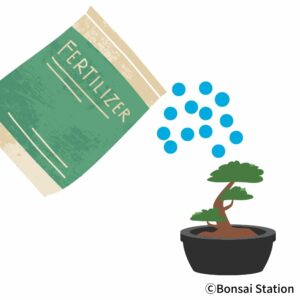
Fertilizing is a crucial component of Japanese zelkova bonsai care that provides essential nutrients for healthy growth and development.
When to fertilize
Fertilize your Japanese zelkova bonsai during the growing season, which typically spans from spring through early autumn (roughly from March to September). This is when your tree is most active and in need of nutrients.
If you plan to defoliate, apply fertilizer in March (or April) when you see new buds starting to appear. Then, give your tree a second dose of fertilizer in May to strengthen tree vigor for the second sprout after defoliation.
In the fall, apply a generous amount of fertilizer to prepare the tree for winter survival and to support new shoots in the upcoming spring.
Stop fertilizing in summer. If you repot in spring, wait about a month for the roots to regrow before starting fertilizing. You do not need to fertilize in winter because your tree is dormant and not taking nutrients in.
Be cautious about applying nitrogen-rich fertilizer in excess because it can make the branches elongate, and the leaves become larger than they should be for a bonsai tree.
Which fertilizer to use
Choose a fertilizer with a higher first number in the N-P-K ratio, indicating an emphasis on nitrogen content which is essential for foliage development. The following product from Amazon is a slow-release bonsai bloom fertilizer with an N-P-K ratio of 18-6-8 and is perfect for your Japanese zelkova bonsai.
Leaves and Soul Bonsai Fertilizer Pellets
You can also choose a balanced bonsai fertilizer with equal or near-equal proportions of nitrogen (N), phosphorus (P), and potassium (K) that will give ideal growth for all bonsai trees including Japanese zelkova bonsai. (N-P-K ratio is 12-11-10 for the following product.)
Styling
Best style for Japanese Zelkova bonsai
While Japanese zelkova bonsai may offer a range of style possibilities including forest style, the broom style, also known as “Hokidachi” in bonsai terminology, is best suited for styling Japanese zelkova bonsai.
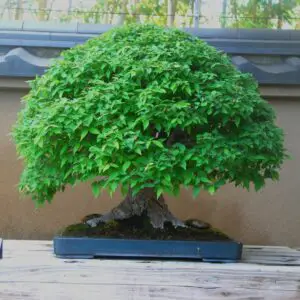
Broom style (summer)
Broom style is a kind of formal upright bonsai style, with an upright, straight trunk with branches radiating symmetrically in a broom-like fashion.
The broom style works perfectly for Japanese zelkova bonsai mainly because Japanese zelkova trees in the wild often have an upright and symmetrical growth habit. This style also accentuates the Japanese zelkova’s natural grace, creating a visually pleasing and balanced bonsai.
Broom style
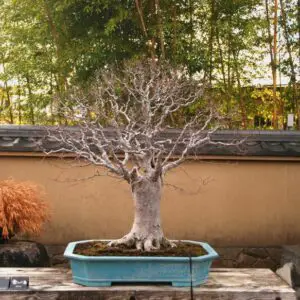
Broom style (winter): The branches are directed upward from the trunk.
Straight Trunk
The central trunk of the broom-style bonsai grows straight upward, serving as the main vertical element of the design.
Symmetrical and radiating branches
The key to the broom style is achieving a balanced and symmetrical structure. Also, branches radiate outward in a symmetric fashion, forming a “broom-like” or “upright broom” appearance.
The branches should not appear crowded or overly dense, and each should have enough space to receive sunlight.
Upward angle branches
Branches in the broom style grow at slightly upward angles from the trunk, creating a broom-like silhouette. This upward branch direction is one of the defining characteristics of this style. In many bonsai styles, branches are typically slanting downward to give the impression of age.
Pruning/pinching
When to prune/pinch
The most important thing to do when taking care of a broom-style Japanese zelkova bonsai is to prune unnecessary branches whenever they appear throughout the growing season. This helps stop elongated branches and encourages ramification, which is necessary for the desired broom-like appearance.
As Japanese zelkova trees continuously produce new leaves during the growing season, you need to observe your tree every day and prune when necessary. It can be twice, three times or more a year depending on the age and health of your tree.
How to prune/pinch
Japanese zelkova trees tend to grow strongly upwards and the top branch of the tree grows the strongest due to strong apical dominance. So, the upper branches need to be pruned harder than the lower branches.
For the upper branches, when the new shoots have 4 to 5 leaves, prune the branch leaving 2 to 3 leaves. For the lower branches, when the new shoots have about 10 leaves, prune the branch leaving 4-5 leaves.
Keep repeating the process during the growing season. This helps keep the growth balanced between the upper and lower parts of the tree, encourages ramification, and creates the broom-like look that you want.
What to do when the branches do not ramify
That said, the number of branches may not increase as expected even if you prune at the right time because Japanese zelkova bonsai trees have strong apical dominance. Only one branch tends to grow from the tip of the branches that are pruned.
In my experience, vigorous and healthy Japanese zelkova trees develop new branches (i.e. ramify into several branches) less than half of the time. This is very common. When I let the branches elongate too long, the branches tend to grow only from the topmost buds even more, making it very challenging to ramify.
In this case, defoliation may help. You may either take off all the leaves or leave the topmost leaf and pinch the other leaves off. This stops the topmost buds from growing strongly and encourages multiple buds to grow.
Defoliating
Benefits
The benefits of defoliation of a Japanese zelkova bonsai tree are three folds:
- It increases the number of fine branches;
- It balances the strength of each branch; and
- It makes the leaves about the same size.
When to defoliate
The best time for defoliation is from early to mid-June.
For young and healthy Japanese zelkova trees, you may be able to do this trimming two to three times before September.
How to defoliate
If your tree is healthy, you can remove all the leaves except the very small ones growing at the base of the branches, leaving only petioles. Defoliate one by one using your fingers or tweezers. Be gentle to avoid harming the buds and fine branches.
As you can imagine, defoliating all leaves is a very stressful process for the tree. If your tree is weak or old, or you are not sure if your tree can tolerate full defoliation, it’s better to use scissors and cut all the leaves in half.
This is less stressful for the tree compared to removing all the leaf parts, and it can still help your tree stay healthy by letting sunlight and air into the foliage.
Wiring
Is wiring necessary?
In general, wiring is less commonly used in the creation and maintenance of the broom style compared to some other bonsai styles. The broom style typically relies more on pruning and pinching techniques as well as the Japanese zelkova tree’s natural, upright growth habit to achieve and maintain its symmetrical and upright appearance.
That said, there may be specific situations where wiring techniques could be used. Japanese zelkova branches grow in an alternating pattern, which can sometimes cause the trunk to bend in a zigzag shape. This is what creates the informal upright style and not the formal upright style like the broom style.
To achieve upright, straight trunk and branches, you need to use wire to straighten any bent parts of the trunk and branches.
When to wire
Wiring Japanese zelkova bonsai can be done anytime during the dormant season except for the coldest months but it’s better to do it just before winter begins. This way, you can leave the wires on for several months until the next spring and wires won’t bite because your tree is dormant.
Remove wires come spring. If the wire damages the bark, it will be a long time before the Japanese zelkova tree bark heals.
Defending against infestation
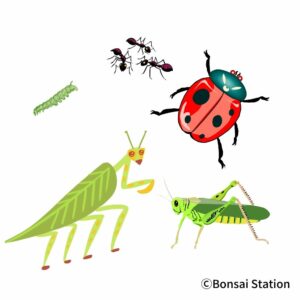
Prevention
Protecting your Japanese zelkova bonsai from pests and diseases is essential to maintaining its health and vitality. For this, prevention is the key; it is way easier than treating or eradicating pests/diseases once they occur.
Check and monitor your trees regularly. Make sure to look at them from all directions. Provide them with the optimal location and environment. And when acquiring new trees, quarantine them for a period to prevent introducing pests or diseases to your other bonsai trees.
Common Japanese zelkova bonsai pests
Aphids are the most common Japanese zelkova pests. Zelkova is a strong tree and is usually pests-free. It is not troubled by many of the common elm problems such as elm leaf beetle and Japanese beetle.
How to treat Japanese zelkova bonsai pests
As a chemical option, I would recommend using neem oil for eradicating pests like aphids. Neem is a tree native to the Indian subcontinent, which acts as an insect repellent and growth inhibitor. Neem oil is safe for plants as well as humans and works perfectly for my bonsai trees.
Common Japanese zelkova bonsai diseases
Common Japanese zelkova diseases include powdery mildew. Zelkova is a strong tree and is usually disease-free. It is resistant to Dutch elm disease, one of the common diseases that infest elm species like Japanese zelkova.
How to treat zelkova bonsai diseases
Neem oil has antifungal and antibacterial properties that can help control certain bonsai diseases.
If neem oil does not work, identify the problem and choose the right product that can treat the disease. There are many different types of fungicides and bactericides available in the market but not all of them work for the problem with your bonsai.
If you are interested in preventing or treating pests and diseases, please read the following article. It is a complete guide that can help you.
Caring in extreme weather
Summer heatwave
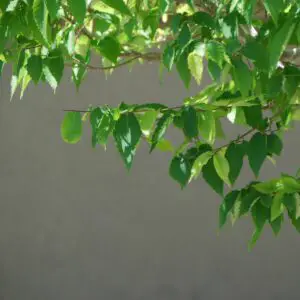
Zelkova bonsai leaves in June
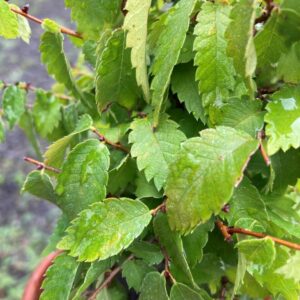
Zelkova bonsai leaves after summer (lost their vibrant color and become yellowish.)
Though Japanese zelkova bonsai thrive in direct sunlight, it does not do well in strong summer sunlight. Leaves may lose vibrant color and become dull and feel dry when touched. It happens because the sun’s ultraviolet rays harm the leaf tissue.
To prevent this and ensure beautiful autumn leaves, move your Japanese zelkova bonsai to a half-shaded location during the hot summer months.
Around September, you can reintroduce your bonsai to direct sunlight to encourage autumn foliage.
Winter cold
Japanese zelkova bonsai can handle cold winter as low as -22°F (-30°C), but their fine branches are vulnerable to frost and dry winds. When exposed to these conditions, the delicate branches may wither and die.
Also, there’s a risk of root damage from the frozen soil if your bonsai is planted in a very shallow pot.
To avoid these issues, move your Japanese zelkova bonsai to a sheltered place, such as under a shelf or in a greenhouse, to protect it from chilly winds and frost after the leaves have fallen. Do not forget to allow your bonsai to experience some cold to help it acclimate to the cold and become cold-hardy. This extra care will keep your Japanese zelkova bonsai healthy through the winter.



